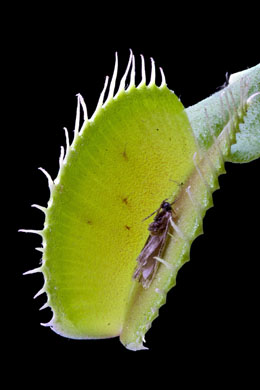Native to the eastern coast of United States, the Venus flytrap derives energy by feeding on insects and arachnids. Read the following Buzzle article to know more.

A cardinal rule which has to be kept in mind about taking care of Venus fly trap is that these plants are unique, exotic, and flesh eating. The reason for such plants being carnivorous is the fact that the places and soil where they grow are short of nutrients, and hence have developed in a way that they thrive on consuming flesh for their survival.
Caring Tips
Soiled with Water?
As this is a bog plant, the soil has to be acidic and it needs constant water. Thus, it is recommended to use peat-based soil if possible. There shouldn't be any trace of lime in it. You can add sand and sphagnum moss to the potting mix. This variety needs a continuous supply of water. If that's not possible, de-ionized water can be used. That will be available in car maintenance shops as it is used for car batteries.
Lights, Camera, Trap
This plant is not at all allergic to light. Pick a spot where it will receive a generous amount of sunlight at least for half part of the day. The leaves grow well as a result of good exposure to sunlight. Fluorescent lights can substitute the sunlight. A 14 hour light cycle for summers and an 8 hour light cycle for winters is perfect.
To Eat is no Mean Feat
Feeding is a necessary part which it does by eating insects on its own. Hence there is no need for external feeding. But if you have to, feed the plant nitrogen and a few other compounds once a week. Make sure you do not feed processed meats. Avoid setting of the trap, as it will consume the energy of the plant without a reward. Feed it with bugs, crickets, insects, and roaches if the plant does not catch the insects on its own.
Additional Instructions
Apart from the instructions given above, take a look at some quick tips on caring for your Venus fly trap.
- Keep dead leaves and heads cut off always for preventing fungal infections.
- The active growing and feeding season is from May through October. In this period the soil has to be constantly damp.
- Flowering should be kept at minimum to avoid from spending and wasting energy.
- Remember that these plants will hibernate in winter.
- Layering the soil is very important.






 A cardinal rule which has to be kept in mind about taking care of Venus fly trap is that these plants are unique, exotic, and flesh eating. The reason for such plants being carnivorous is the fact that the places and soil where they grow are short of nutrients, and hence have developed in a way that they thrive on consuming flesh for their survival.
A cardinal rule which has to be kept in mind about taking care of Venus fly trap is that these plants are unique, exotic, and flesh eating. The reason for such plants being carnivorous is the fact that the places and soil where they grow are short of nutrients, and hence have developed in a way that they thrive on consuming flesh for their survival.